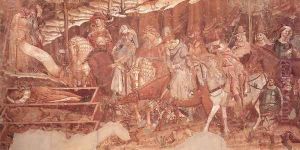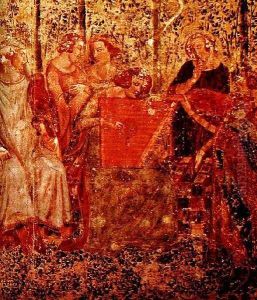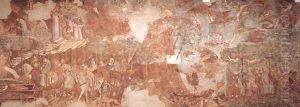Bounamico Buffalmacco Paintings
Buonamico di Cristofano, more widely known as Buonamico Buffalmacco, was an Italian painter of the Guelph faction who is best remembered for his work in the early Trecento (14th century) period. Born around 1262, likely in Florence, Buffalmacco was a prominent figure in the transition from the Byzantine style to more naturalistic representations, contributing significantly to the development of early Italian Renaissance art. His life and career are somewhat blurred by legend, largely thanks to Giorgio Vasari's 'Lives of the Most Excellent Painters, Sculptors, and Architects', where Vasari portrays him as a practical joker. Despite the entertaining anecdotes, this has somewhat overshadowed his actual contributions to art and architecture.
Buffalmacco is most famous for his frescoes in the Camposanto Monumentale in Pisa, particularly the 'Triumph of Death', 'The Last Judgment', and scenes from 'The Life of the Holy Fathers', painted around 1336-1341. These works are celebrated for their dramatic intensity, emotional depth, and innovative use of space and perspective. His style demonstrates an evolution from the rigid and formal Byzantine tradition towards a more naturalistic and narrative-driven approach, embodying the early stages of Renaissance art.
Beyond his work in Pisa, Buffalmacco was active in Florence and possibly other Tuscan cities, contributing to the decoration of various churches and public buildings. His influence was significant in the development of Italian painting, paving the way for later Renaissance masters by demonstrating the potential of fresco and narrative art to evoke emotional response and convey complex theological concepts.
Despite the considerable fame during his lifetime and the immediate centuries that followed, detailed records of Buffalmacco's life are scarce, and many works attributed to him have been lost or are difficult to firmly attribute due to the lack of signed pieces. However, his reputation as a pioneering figure in the development of Italian Renaissance art remains intact. Buffalmacco's legacy is that of an artist who bridged the medieval and Renaissance worlds, both through his innovative artistic techniques and through the vivid character sketches provided by his contemporaries and later writers like Vasari. He is believed to have died around 1340, leaving behind a body of work that continues to be studied and admired for its creativity and insight into the transitionary period of European art.


